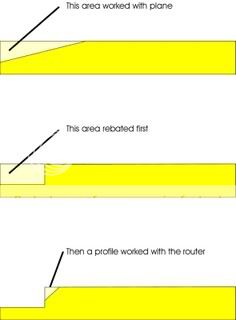Hi all,
I've been asked to completely redo a kitchen which wouldn't be to special but this will be the first time I've had to make my own solid wood(Hardwood) doors. I've done a fair few cabinets in softwood through the years but i have to admit i'm feeling a bit apprehensive working with hardwood. :?
I've done extensive building work for this customer in the past so i have a high rep to uphold.
Now 'The Brief' was along the line of they've been looking at kitchens for a while now and haven't seen anything good. I got to admit there is very little choice out there, it's all Shaker, Gloss or wrapped mdf. And there existing kitchen is Oak Cathedral doors way to dark and grubby.
So what i can gather is they want a door design between contemporary design and classic design in a light wood. So I propose Steamed Beech wood rail and style door with a rectangle raised panel. The same for the draws only i'm going to halve the rails to get a 80mm raised panel in on the narrow draws. Anyone understanding this babble? I'm planning on making a sample this weekend.Any thoughts on design would be appreciated.
Now the problem, i've had no experiance with raised panels. I bought freud pro raised panel router bit set few years ago and didn't use it .So i dug it out it has 3" cutter and combination cutter. The problem is they state max 12000 for 3" and 16000rpm for the comb but my old Makita 3612 has no speed control 22 000rpm, real brute with no soft start. Can anything be done?
I've also got a combination machine with spindle moulder on it. I have 90mm euro block which i have the NO.97 40mm cutter for rail and style. But no raised panel cutters. I don't want to break the bank but has anyone got any recomendations for spindle moulder raised panel cutter?
Also finishing beech? I usaully do three coats acrylic polyurthane Satin and rub fine paste wax on with 0000 steel wool for satin rubbed finish. But would this be any good on beech.
So many questions......I know, just got a lot on the go at the moment.
Anyway i keep you all posted if you guys want maybe some progress pics.
Alex
I've been asked to completely redo a kitchen which wouldn't be to special but this will be the first time I've had to make my own solid wood(Hardwood) doors. I've done a fair few cabinets in softwood through the years but i have to admit i'm feeling a bit apprehensive working with hardwood. :?
I've done extensive building work for this customer in the past so i have a high rep to uphold.
Now 'The Brief' was along the line of they've been looking at kitchens for a while now and haven't seen anything good. I got to admit there is very little choice out there, it's all Shaker, Gloss or wrapped mdf. And there existing kitchen is Oak Cathedral doors way to dark and grubby.
So what i can gather is they want a door design between contemporary design and classic design in a light wood. So I propose Steamed Beech wood rail and style door with a rectangle raised panel. The same for the draws only i'm going to halve the rails to get a 80mm raised panel in on the narrow draws. Anyone understanding this babble? I'm planning on making a sample this weekend.Any thoughts on design would be appreciated.
Now the problem, i've had no experiance with raised panels. I bought freud pro raised panel router bit set few years ago and didn't use it .So i dug it out it has 3" cutter and combination cutter. The problem is they state max 12000 for 3" and 16000rpm for the comb but my old Makita 3612 has no speed control 22 000rpm, real brute with no soft start. Can anything be done?
I've also got a combination machine with spindle moulder on it. I have 90mm euro block which i have the NO.97 40mm cutter for rail and style. But no raised panel cutters. I don't want to break the bank but has anyone got any recomendations for spindle moulder raised panel cutter?
Also finishing beech? I usaully do three coats acrylic polyurthane Satin and rub fine paste wax on with 0000 steel wool for satin rubbed finish. But would this be any good on beech.
So many questions......I know, just got a lot on the go at the moment.
Anyway i keep you all posted if you guys want maybe some progress pics.
Alex










































